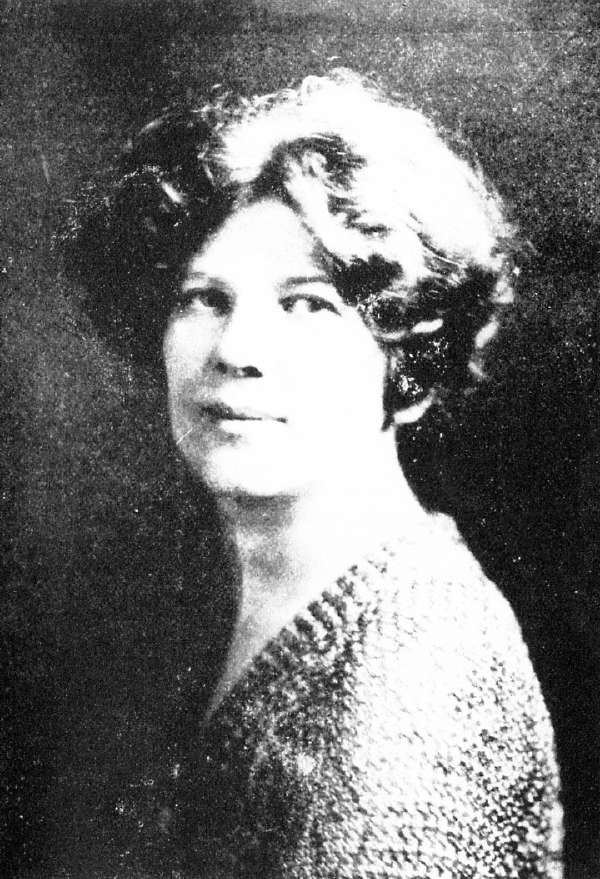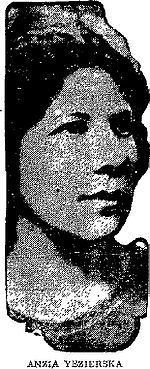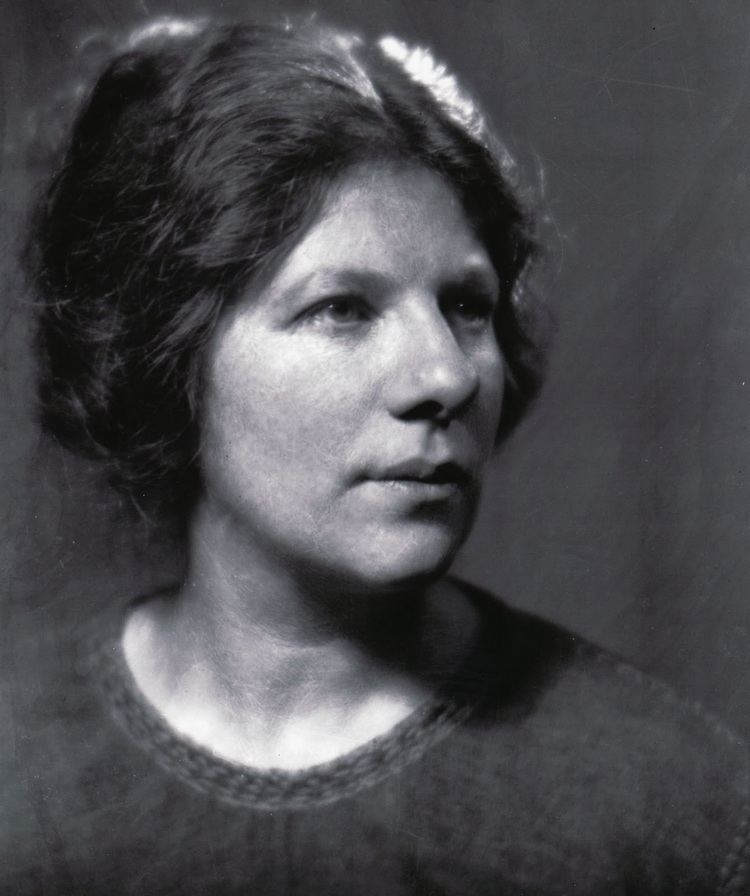Nationality United States Name Anzia Yezierska Movies Salome of the Tenements | Genre fiction; non-fiction Role Novelist | |
 | ||
Occupation Writer, novelist, essayist Died November 21, 1970, California, United States Books Bread Givers, Hungry Hearts, Arrogant beggar, How I Found America, Salome of the tenements | ||
Anzia yezierska s intro in soul of a people writing america s story
Anzia Yezierska (1885–1970) was a Jewish-American novelist born in Maly Plock, Poland, which was then part of the Russian Empire. She emigrated as a child with her parents to the United States, and lived in the immigrant neighborhood of the Lower East Side of Manhattan.
Contents
- Anzia yezierska s intro in soul of a people writing america s story
- SWEATSHOP CINDERELLA Women Make Movies Trailer
- Personal life
- Writing career
- Yezierska and Hollywood
- Works by Anzia Yezierska
- Quotes
- References

SWEATSHOP CINDERELLA | Women Make Movies | Trailer
Personal life

Yezierska was born in the 1880s in Maly Plock to Bernard and Pearl Yezierski. Her family emigrated to America around 1890, following in the footsteps of her eldest brother Meyer, who had arrived in the States six years prior. They took up housing in the Lower East Side, Manhattan. Her family assumed the surname Mayer, while Anzia took Harriet (or Hattie) as her first name. She later reclaimed her original name, Anzia Yezierska, in her late twenties. Her father was a scholar of Torah and sacred texts.

Anzia Yezierska's parents encouraged her brothers to pursue a higher education but believed she and her sisters had to support the men.

In 1910 she fell in love with Arnold Levitas, but instead married his friend Jacob Gordon, a New York attorney. After 6 months, the marriage was annulled. Shortly after, she married Arnold Levitas in a religious ceremony to avoid legal complications. Arnold was the father of her only child, Louise, born May 29, 1912.

Around 1914 Yezierska left Levitas and moved with her daughter to San Francisco. She worked as a social worker. Overwhelmed with the chores and responsibilities of raising her daughter, she gave up her maternal rights and transferred the girl to Levitas.

She then moved back to New York City. Around 1917, she engaged in a romantic relationship with philosopher John Dewey, a professor at Columbia University.

After she had become independent, her sister encouraged her to pursue her interest in writing. She devoted the remainder of her life to it.
Yezierska was the aunt of American film critic Cecelia Ager. Ager's daughter became known as journalist Shana Alexander.
Anzia Yezierska died November 21, 1970 of a stroke in a nursing home in Ontario, California.
Writing career
Yezierska wrote about the struggles of Jewish and later Puerto Rican immigrants in New York's Lower East Side. In her fifty-year writing career, she explored the cost of acculturation and assimilation among immigrants. Her stories provide insight into the meaning of liberation for immigrants—particularly Jewish immigrant women. Many of her works of fiction can be labeled semi-autobiographical. In her writing, she drew from her life growing up as an immigrant in New York's Lower East Side. Her works feature elements of realism with attention to detail; she often has characters express themselves in Yiddish-English dialect. Her sentimentalism and highly idealized characters have prompted some critics to classify her works as romantic.
Yezierska turned to writing around 1912. Turmoil in her personal life prompted her to write stories focused on problems faced by wives. In the beginning, she had difficulty finding a publisher for her work. But her persistence paid off in December 1915 when her story, "The Free Vacation House" was published in The Forum. She attracted more critical attention about a year later when another tale, "Where Lovers Dream" appeared in Metropolitan. Her literary endeavors received more recognition when her rags-to-riches story, "The Fat of the Land," appeared in noted editor Edward J. O'Brien's collection, Best Short Stories of 1919. Yezierska's early fiction was eventually collected by publisher Houghton Mifflin and released as a book titled Hungry Hearts in 1920. Another collection of stories, Children of Loneliness, followed two years later. These stories focus on the children of immigrants and their pursuit of the American Dream.
Some literary critics argue that Yezierska's strength as an author was best found in her novels. Her first novel, Salome of the Tenements (1923), was inspired by her friend Rose Pastor Stokes. Stokes gained fame as a young immigrant woman when she married a wealthy young man of a prominent Episcopalian New York family in 1904.
Her most studied work is Bread Givers (1925). It explores the life of a young Jewish-American immigrant woman struggling to live from day to day while searching to find her place in American society. Bread Givers earned Yezierska critical acclaim and respect as a mature artist. Bread Givers remains her best known novel.
Arrogant Beggar chronicles the adventures of narrator Adele Lindner. She exposes the hypocrisy of the charitably run Hellman Home for Working Girls after fleeing from the poverty of the Lower East Side.
In 1929–1930 Yezierska received a Zona Gale fellowship at the University of Wisconsin, which gave her a financial stipend. She wrote several stories and finished a novel while serving as a fellow. She published All I Could Never Be (1932) after returning to New York City.
The end of the 1920s marked a decline of interest in Yezierska's work. During the Great Depression, she worked for the Federal Writers Project of the Works Progress Administration. During this time, she wrote the novel, All I Could Never Be. Published in 1932, this work was inspired by her own struggles. As portrayed in the book, she identified as an immigrant and never felt truly American, believing native-born people had an easier time. It was the last novel Yezierska published before falling into obscurity.
Her fictionalized autobiography, Red Ribbon on a White Horse (1950), was published when she was nearly 70 years old. This revived interest in her work, as did the trend in the 1960s and 1970s to study literature by women. "The Open Cage" is one of Yezierska's bleakest stories, written during her later years of life. She began writing it in 1962 at the age of 81. It compares the life of an old woman to that of an ailing bird.
Although she was nearly blind, Yezierska continued writing. She had stories, articles, and book reviews published until her death in California in 1970.
Yezierska and Hollywood
The success of Anzia Yezierska's early short stories led to a brief, but significant, relationship between the author and Hollywood. Movie producer Samuel Goldwyn bought the rights to Yezierska's collection Hungry Hearts. The film of the same title was shot on location at New York's Lower East Side with Helen Ferguson, E. Alyn Warren, and Bryant Washburn. In recent years, the film has been restored through the efforts of the National Center for Jewish Film, the Samuel Goldwyn Company, and the British Film Institute. In 2006, a new score was composed to accompany the film. Yezierska's 1923 novel Salome of the Tenements was adapted and produced as a silent film by the same name. The San Francisco Jewish Film Festival showed the restored print in July 2010.
Recognizing the popularity of Yezierska's stories, Goldwyn gave the author a $100,000 contract to write screenplays. In California, her success led her to be called by publicists, "the sweatshop Cinderella." She was uncomfortable with being touted as an example of the American Dream. Frustrated by the shallowness of Hollywood and by her own alienation, Yezierska returned to New York in the mid-1920s. She continued publishing novels and stories about immigrant women struggling to establish their identities in America.
Works by Anzia Yezierska
Quotes
Poverty was an ornament on a learned man like a red ribbon on a white horse
A man is free to go up as high as he can reach up to; but I - with all my style and pep - can't get a man my equal because a girl is always judged by her mother
The trouble with us is that the ghetto of the Middle Ages and the children of the twentieth century have to live under one roof
